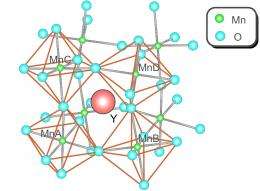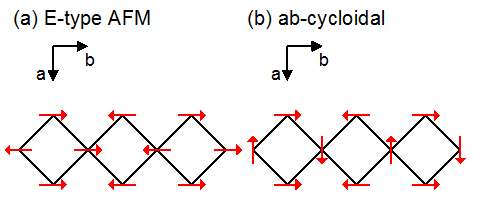Origin of large polarization in multiferroic YMnO3 thin films

Multiferroic materials have attracted much interest because of their ability to control magnetism through the application of a voltage. This ability can be utilized to reduce the power required by electronic devices and to increase their speed. However, the number of multiferroic materials discovered has been small, and ferromagnetism and ferroelectricity in the already discovered materials are often weaker than the required values for using them as ferromagnets and ferroelectrics. Hence, novel multiferroic materials are being extensively sought.
In 2011, a team from the University of Tokyo and RIKEN (Institute of Physical and Chemical Research) has succeeded in fabricating a YMnO3 multiferroic film that has dielectric polarization exceeding that of conventional multiferroic thin films. The team employed X-ray diffraction to investigate the magnetic structure and lattice strain of this film and discovered the origin of polarization. This achievement is expected to lead to the design of useful multiferroic materials.
The team further investigated the origin of large polarization of YMnO3 thin films (thickness: 40 nm) by measuring soft and hard X-ray diffraction of the magnetic structure and lattice structure, with a research team in KEK, the High Energy Accelerator Research Organization by using KEK's Photon Factory and Swiss Light Source.

These measurements confirmed that the spin of Mn ions has two coexisting magnetic structures, namely the cycloidal and E-type antiferromagntic (AF) orderings. In addition, it was found that below 40 K, small electric polarization appears as a result of the cycloidal ordering because the periodicity of the cycloidal magnetic structure is incommensurate with the crystal lattice. The E-type AF ordering appears in addition to the cycloidal ordering below 35 K. The periodicity of the E-type AF ordering is commensurate with the crystal lattice, and the lattice strain due to interactions between ions with parallel spins was found to be the cause for the large polarization.
More information: H. Wadati, J. Okamoto, M. Garganourakis, V. Scagnoli, U. Staub, Y. Yamasaki, H. Nakao, Y. Murakami, M. Mochizuki, M. Nakamura, M. Kawasaki, and Y. Tokura, Origin of the large polarization in multiferroic YMnO3 thin films revealed by soft and hard x-ray diffraction, Physical Review Letters, Published Jan. 27, 2012.
Journal information: Physical Review Letters
Provided by University of Tokyo



















